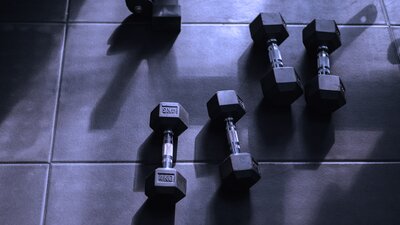At some point in their fitness journey, everyone wonders about the differences between machines and free weights. Initially, both machines and free weights can seem confusing and intimidating, but understanding their differences can help you use both confidently. The truth is that both are effective tools for strength and hypertrophy (1, 2, 3).
Machines:
- Include plate-loaded or weight stack machines.
- Are stabilized by the machine.
- May need adjustments, such as seat adjustments.
- Offer less creativity.
- Provide constant tension.
Free Weights:
- Include dumbbells, barbells, and kettlebells.
- Are stabilized by the body.
- Require no adjustments.
- Offer more creativity.
- Provide a tension curve.
Stability
Stability is a major difference between machines and free weights (1, 2, 3). When using a machine, there is no way for the machine’s weight to fall onto the floor, and the machine’s arms do not deviate from the designed movement path. In contrast, free weights can fall onto the floor, and the lifter must stabilize them, ensuring they follow the intended movement path.
The machine's structure provides stability, whereas stability is provided by your body when lifting free weights. This isn’t to say that machines don’t require stability. Indeed, you should still stabilize your shoulder blades when using a lat pulldown machine, but it takes only a fraction of the focus and intention to stabilize as it does with free weights.
Free weights require focusing on stability at every joint to create maximum force safely. For a chest exercise with a machine, you just push the handles forward. However, for a barbell bench press, you must be aware of creating a stable bar path with nearly half a dozen techniques because that bar can move outside a proper bar path in many ways.
User-Friendliness
Free weights, like dumbbells, offer countless exercises to choose from. On the other hand, most machines have only one primary way to use them. Deciding on a free weight exercise can be overwhelming, which may make a machine appear more appealing. Regarding safety, it is unclear if one modality has a higher risk for injury than another (1).
Machines can be daunting, as people may feel embarrassed about using them incorrectly. Fortunately, most machines have instructions, illustrations of how muscles work, and even QR codes to help users learn how to operate them. Since free weights can be moved infinitely, they require more focus and practice to master the techniques.
Isolation
When training with free weights, most exercises are compound movements, meaning they train more than one joint at a time (think squat versus leg extension). Compound exercises train more muscles due to the nature of more joints involved than in single-joint exercises. Machines, however, offer more options for isolating specific muscles or a specific joint.
In addition, most machines place constant tension on the muscles throughout the range of motion, whereas free weights follow a tension curve where tension is greater at certain points.
How Much Should I Train Machines versus Free Weights?
To answer this question, it depends on the goal. Both machines and free weights increase strength and hypertrophy. According to the principle of specificity, you will adapt to and become more proficient in what you spend more time training (1).
So if you want to get strong at a barbell deadlift, you would not want to prioritize using a leg machine. Rather, you would want to prioritize the barbell deadlift. You could add in some machine exercises to supplement your workout.
We think that beginners working out on their own can benefit from using machines for the majority of their program to:
Reduce the barriers to exercise that free weights can have
Familiarize themselves with the major movements, such as push, pull, and squat
For non-beginners, machines are still a great tool to use in the gym, especially towards the end of a workout after free weight compound exercises have built up fatigue for doing alternate sets such as drop-sets, and variety.
Outro
Both machines and free weights have a legitimate place in any training program. Machines offer more stability to the body, are typically easier to learn, and are more straightforward in their limited use. On the other hand, free weights offer freedom in their use and require the body to provide stability.
"Individuals... should consider the specificity of exercise, and how their strength and power will be tested and applied. Individuals looking to increase general strength and muscle mass... may choose whichever activity they prefer and are more likely to adhere to" (Heidel, 2022).
Sources
Haugen ME, Vårvik FT, Larsen S, Haugen AS, van den Tillaar R, Bjørnsen T. Effect of free-weight vs. machine-based strength training on maximal strength, hypertrophy and jump performance - a systematic review and meta-analysis. BMC Sports Sci Med Rehabil. 2023 Aug 15;15(1):103. doi: 10.1186/s13102-023-00713-4. PMID: 37582807; PMCID: PMC10426227.
Heidel KA, Novak ZJ, Dankel SJ. Machines and free weight exercises: a systematic review and meta-analysis comparing changes in muscle size, strength, and power. J Sports Med Phys Fitness. 2022 Aug;62(8):1061-1070. doi: 10.23736/S0022-4707.21.12929-9. Epub 2021 Oct 5. PMID: 34609100.
Schwanbeck SR, Cornish SM, Barss T, Chilibeck PD. Effects of Training With Free Weights Versus Machines on Muscle Mass, Strength, Free Testosterone, and Free Cortisol Levels. J Strength Cond Res. 2020 Jul;34(7):1851-1859. doi: 10.1519/JSC.0000000000003349. PMID: 32358310.

